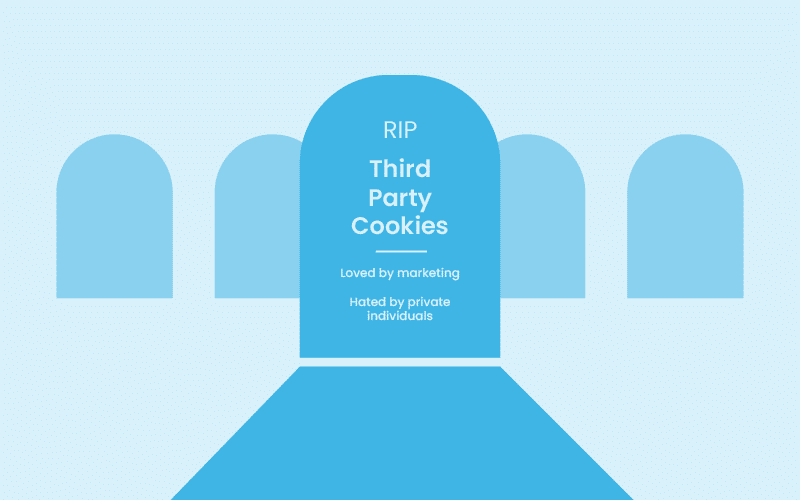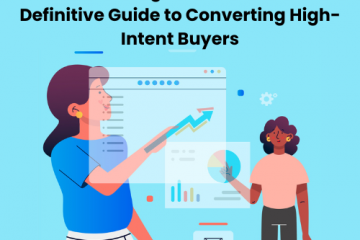How To Collect First-Party Data?
Have you ever thought about buying a product and then seen ads for similar products pop up in your searches on Google or your social media feeds everywhere? Customers often marvel at this phenomenon, but as it turns out—it is not rocket science! Tracking user activities over the internet has become so advanced that an unconscious click on an ad could lead to you being targeted with relevant ones for weeks or months. Many customers find it an invasion of their privacy.
But how does Google, or any other search engine, track every activity on the web so conspicuously? With third-party cookies, of course! Third-party cookies have led to a proliferation of personally identifiable information, which raises many privacy concerns in direct contempt of data security and compliance regulations like the GDPR. Most companies gather user information using third-party cookies to later target customers with relevant product ads, but it also leaves these individuals open to identity thefts and other data breach issues, should the company suffer a cyberattack or a hacking attempt.
This is why Google decided in 2020 to phase out third-party cookies on their Chrome browsers entirely by 2022 (later extended to 2024). According to this Google post, they will not build “alternate identifiers to track individuals as they browse across the web, nor use them in our products.” Their plan is to develop privacy-preserving APIs to cater to the needs of analysts and marketers. But as it is with every new technology, this phase-out will take some time and meanwhile, marketers need to fall back on something reliable to help report on ad campaign performance and customer data. This is where first-party cookies come in.
While the mainstream usage of first-party and zero-party data is still at infancy, a study conducted by Google in partnership with Boston Consulting Group has revealed that key marketing activities using first-party data reported generating 2.9x the revenue while saving 1.5x the costs compared to those that don’t. In short, first-party data is the future of marketing analysis. In this blog, we will explore the death of third-party cookies and dive into how first-party data is the better alternative and can help your marketing team optimize campaigns without invading your customer’s privacy and adhering to global security standards.
Many countries in the EU, including Austria, France, and Italy have banned Google Analytics. In light of how Google collects personally identifiable information (PII) and stores them in databases in the US, using the capabilities of Google Analytics could find your company in direct violation of the GDPR guidelines.
Regulatory bodies across the globe are taking the rising trend of data concerns very seriously, which is why compliance laws are cracking down on the usage of third-party cookies by companies like Google and Facebook. These big-data corporations have no strict guidelines outlining how the data collected by third-party cookies is deemed to be used, thus, leaving a huge margin for data breaches and loss of PII. The penalties for non-compliance may cost companies hundreds of thousands of dollars, and organizations would rather keep their money than risk using the data.
Foreseeing this situation, Google Analytics launched GA4. In order to effectively track user data while retaining the users’ anonymity, Google is now encouraging webmasters to use its Privacy Sandbox and use FLOC and Fledge (Protected Audience API). While both B2C companies and customers will benefit from this decision, B2B companies who require the data for purposes other than bulk advertising and analytics may have difficulty.
With GA4, Google’s perspective seems to be shifting from cookie-based tracking to event-based customer journey mapping, which automatically makes first-party data highly relevant, compared to third-party data. Ensuring privacy is an imminent need in the future, and GA4 still doesn’t completely mitigate all concerns surrounding sharing and storage of PII. This is why tools that enable first-party data tracking are going to be very popular in the coming times. As internet users grow more aware of where their information is going, the usage of first-party data will continue gaining relevance, eventually resulting in the death of third-party cookies altogether.

Image Source: XIST2
What is First-Party Data?
First-party data is the information that businesses can obtain from their own sources. In other words, first-party data refers to all data about customers that come from both online and offline sources, including the company’s website, app, CRM, social media platforms, or surveys. It is exclusively collected by the company that gathers it.
Here are some examples of first-party data:
- Web activities tracked for analytics or customer journey tracking
- Website interaction metrics like time spent on the website, pages viewed, etc.
- Social media engagement metrics
- Email addresses and phone numbers collected through a contact form
- Product usage and location data collected through mobile applications
- Demographic information like age, gender, occupation, etc., from surveys
- Customer feedback from loyalty and affiliate programs
- Purchase history from e-Commerce transactions made online or in-store
First-party data can be collected easily and the business that owns it has all necessary customer consent. The latter is crucial in the age of stringent compliance requirements, like the GDPR guidelines. Moreover, a data platform like Salespanel can easily help you easily segment and leverage the data for your sales and marketing requirements. You may give your consumers personalized experiences and show them relevant ads using first-party data.
How Do You Collect First-Party Data?
You can collect first-party data from various places like your website, mobile apps, CRMs, emails, and customer service interactions, etc.
Websites: You can gather both demographic as well as psychographic data on your visitors from your website, including names, email addresses, phone numbers, and details about their actions and preferences.
Mobile apps: They can be used to extract similar data, plus you can also find out which sections of your app need to be optimized, based on how frequently users check them out.
Emails: The metrics from your email campaigns (opens, clicks, unsubscribes, spam complaints, etc.) can be used to understand what content your consumers prefer, and what they find annoying. Such information can be instrumental in optimizing marketing campaigns. Plus, this information is crucial to assess for any B2B customer journey.
CRM platforms: CRMs have a lot of context and historical information regarding your business. Past purchases from a customer, deal size entered by the sales rep, pipeline metrics, etc. are all first-party data points.
Customer service interactions: Your support team’s interactions with your customers can count as very insightful first-party data. You may learn more about customer requirements and issues that customers may face. Such customer feedback can be utilized to empower sales reps and account managers, refine your marketing strategies and offer more relevant ads, targeted towards conversions.
We discussed the “where” and the “what”. Now let’s discuss the “how”. It is time for some first-party data collection strategies! Here are five of the best ones:
1. Website tracking
Collecting first-party data from your website offers deep insights into user behavior and engagement. By employing tracking technologies like cookies or utilizing analytical tools, businesses can capture a range of data points, including user preferences, browsing patterns, and demographic details. Specialized tools can also help you track entire customer journeys across your websites and applications and connect the data to sales and marketing operations.
2. User registration
The most straightforward way to get customer data is to ask your customer for it directly using forms. Webforms can be used for product sign-ups, scheduling demos, newsletters, or downloading gated content.
For incentivizing your prospects, you may provide new users a discount on any product or service listed on your website, or you could also send them a freebie, thanking them for registering.
3. Tracking based on events
With event-based tracking, you may gather comprehensive behavioral information about your users.
Numerous analytical and behavioral tracking solutions exist that enable event-based tracking. You can use these clever technologies to set up event tracking and supply first-party data to other systems.
4. Sharing content (primarily for B2C)
User-generated content (UGC) can be key to understanding which of your products or which aspects of your marketing are winning over your customers. You can profit from UGC by sharing it on multiple media platforms, and even create a section highlighting it on your website. Nothing makes a customer feel more engaged by a brand than seeing their content being highlighted by the company.
Content sharing increases the amount of first-party data you have in your database, whether it be written content, video content, or goods and services. You can enable content sharing on your website or app, to promote further interaction amongst your target audience.
5. Product registrations or warranties (primarily for B2C)
Most businesses do not understand the potential of these opportunities, but a user registering their product in your portal or adding extra warranties could be a great way to gather first-party data. To engage new customers and have their information scanned into your database, try placing QR stickers on your products. You can further use emails to foster a long-lasting relationship over time.
Data Compliance Requirements for Collecting First-Party Data
One of the major reasons organizations are shifting to first-party data collection is to comply with data regulations and focus on customer privacy. Every individual company is responsible for their own first-party data collection and the consents they have to get from their customers, which makes first-party data absolutely transparent, and thus, very trusted and valuable. With the customers knowing what information they are sharing with the company, it can get them to agree to share the relevant data faster, and without worrying about whether their privacy may be at risk later.
When assessing whether your first-party data complies with security standards, there are two major considerations you must comprehend:
- Whether the data has been collected legally in accordance with national and international compliance requirements, and,
- Whether integrating the data with your digital marketing channels will raise privacy concerns.
For starters, your first-party data collection and storage processes must comply with the requirements of security standards like the CCPA and the GDPR. Both frameworks have stringent laws outlined in them, and the data you collect must satisfy the legal conditions highlighted there, including the prerequisites for storage and accessibility.
Coming to the integration of first-party data with digital marketing channels, there are a few things you need to evaluate.
One of the universal requirements imposed by compliance standards is the hashing of first-party data. Hashing involves transforming your first-party data into a random string of numbers and letters by parsing it to essentially anonymize the data.
Next, we have tracking. Websites tracking user behavior and other metrics have to use GDPR-compliant modeling and language that confirms that users understand which of their data is being tracked and consent to the same. The user must be made aware of the different degrees of tracking and given the option to opt out.
Finally, the last thing businesses need to consider is their domain structure. First-party data is collected in sets, and Google has stated that a brand can only extract data and analytics from five domains. Now, for companies that have multiple domains for vanity or country-specificity, this can be a difficult task. You will need to chalk out the pros and cons carefully before starting on this process. Keep your eyes open for alternatives as it is not necessary to be bound by Google’s system.
First-party data collection accommodates for user privacy and data compliance requirements in marketing, which is why it is being increasingly adopted as the best choice for brands to track customer journeys and inform their marketing decisions.
Collecting First-Party Data from Website and Using it for Marketing Operations
Your website is your biggest and most valuable source of first-party data. You can not only extract demographic information (like a user’s age, gender, occupation, education, location, etc.) but also behavioral data (like their interests, activities, behaviors, etc.). Moreover, most website tracking and analytics tools come with features that allow you to see which pages on your website your visitors mostly check out, which sections they hover on before making a purchase, how much time they spend on your website, and much more. This kind of information can be very useful for re-targeting strategies.
The data you gather from your website can be used for the following purposes —
- Enhancing consumer experience with personalization and showing relevant content and ads; this can be especially valuable in A/B testing landing pages and creating paid ad campaigns.
- Re-targeting using ad campaigns and abandonment email workflows.
- finding fresh audiences and breaking into new markets; with the data clearly indicating what the existing customers like (or don’t like), creating content that will appeal to new prospects and increase brand awareness becomes easy.
- Improving consumer base segmentation, especially for account-based marketing campaigns.
To create a first-party data collection strategy that extracts valuable insights from your website and informs your marketing operations, you need to follow these steps:
1. Build a roadmap showing exactly how you plan to use your first-party data:
First-party data serves as the cornerstone of a more comprehensive omnichannel marketing approach that can help organizations in achieving lower-funnel goals like customer retention, loyalty, and upselling. You must start by establishing the strategies and data needed to carry out the plan, as well as your marketing and customer experience goals and objectives. Also, you should construct a roadmap for how your cross-channel marketing skills will advance over time and divide the long-term effort into smaller tasks that demonstrate increasing returns at each level.
2. Determine which data sets and sources you will be using:
To find out what data is being generated and how it is being measured, you must audit your data sources. You have to ensure that you capture the data that is crucial to achieving your goals by cross-referencing your data sources and data points with the data needs of the marketing and analytics use cases you intend to implement.
3. Maximize the potential of first-party data:
In any situation, the ability to personalize and meaningfully engage with customers depends on first-party data. You have to create a company-wide identity asset by combining physical and digital data to generate customer-centric strategies that align marketing, product, and service.
4. Benchmark your best results and continually strive for better:
You must evaluate your first-party data capabilities on a regular basis, track your development, and incorporate your learnings as you go. Determine the key performance indicators for your marketing campaigns in terms of operational capability and assistance with cross-channel promotions, right from the start. Besides this, keep track of the amount of data, the sources, the processing speed, the depth of the profile, and the data that is being used for analytics and other assessments.
Collect First-Party Data with Salespanel
If you are looking for a B2B visitor intelligence and website analytics tool that is ready for a cookie-less future, look no further than Salespanel. This software provides you with a central data platform that aggregates all website and app touchpoints, monitors entire customer journeys, and provides valuable insights on what’s working (and what’s not!) to inform the optimization of various marketing channels.
Salespanel essentially enables you to track first-party website data and attribute it directly to your customers. As a result, it gives you trusted information that has a direct connection to your customers, unlike traditional analytics, which gives you comprehensive data for analytics. This is perfect for B2B companies that want to score prospects, automate processes, or personalize their marketing to sell more effectively. Moreover, Salespanel now supports cookieless cross-domain cross-platform that is unaffected by bans or restrictions on third-party cookies.
With the data you derive from tracking your website on Salespanel, you can create segmented cohorts of your prospects and customers to determine your own milestones and KPIs for customer journey tracking. Every data point can be used to score your leads and segment them based on their intent and behavior. This tool also combines the data from your website and your application, to provide you with meaningful insights for data-driven marketing.
Moreover, Salespanel addresses controversies surrounding Google Analytics —by not monetizing the first-party data it collects at “rest” and by enabling GDPR-compliant site tracking (which only begins once the consent management system receives the user’s agreement). It also avoids using third-party cookies and nefarious data collection techniques used by many other products in the segment. Additionally, it has never shared and will never share data with outside advertising agencies.

Final Thoughts
The age of third-party data is nearing an end—it is time for you to focus on refining your first-party data collection processes and strategies. First-party data comes with more possibilities, and progressive marketers are already beginning to recognize its importance in a data-driven marketing strategy.
Integration of first-party data is essential as a component of your strategy since you need to gather information about your customers to create a profile of each one and target them with messages that are specifically tailored to them. Marketers may create a data asset that acts as the basis for all consumer engagements across the web, mobile apps, retail, email, digital marketing, contact centers, and beyond—by utilizing all of a brand’s first-party data to resolve customer identity.
If you want to learn how Salespanel can help you process first-party data, talk to us!
Sell more, understand your customers’ journey for free!
Sales and Marketing teams spend millions of dollars to bring visitors to your website. But do you track your customer’s journey? Do you know who buys and why?
Around 8% of your website traffic will sign up on your lead forms. What happens to the other 92% of your traffic? Can you identify your visiting accounts? Can you engage and retarget your qualified visitors even if they are not identified?


